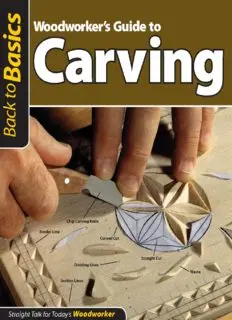
Woodworker’s Guide to Carving: Straight Talk for Today’s Woodworker PDF
Preview Woodworker’s Guide to Carving: Straight Talk for Today’s Woodworker
Contents Introduction Chapter 1: Carving Tools Chapter 2: Getting Started Chapter 3: Incised Carving Chapter 4: Relief Carving Chapter 5: Carving in the Round Index What You Can Learn Carving Tools, p. 12 Despite the enormous variety of tools at a woodworker’s disposal, most carvers perform their work with a dozen or so tools. Getting Started, p. 40 Nothing takes the place of practice, but you can master the basics of carving with a few deft movements of a chisel. Incised Carving, p. 58 To the uninitiated, chip carving may seem complex but it is actually a fairly straightforward process, with room for infinite variation. Relief Carving, p. 82 The techniques of relief carving can be applied to a variety of subjects from bowls to scenery. Carving in the Round, p. 122 Whether the piece is a bust, a wildlife carving, or a design element on a claw-and-ball foot, you should undertake a careful study of the project before beginning. Chip Carving As a small child I was fascinated with every aspect of wood: its feel, its smell, and the ever-changing beauty of its grain. From as far back as I can recall, my father supplemented the family income by pursuing his passion of furniture refinishing and antique restoration. And, from the age of five, under the watchful eye of my Norwegian grandfather who lived with us, I was tutored in carving wood. Thus began a wandering journey that would bring a lifetime of joy, excitement, challenges, and friendships. Working with wood, from topping trees to boatbuilding, was an activity I continued into adulthood and the one that gave me my greatest pleasure. So when the opportunity to study in the woodcarving center of Brienz, Switzerland, presented itself, I thought the world had stopped to let me on. This was the chance of a lifetime. The experience of carving in the midst of masters whose skills were rooted in centuries of knowledge and tradition proved exhilarating. Learning carving from these craftsmen included acquiring discipline and an appreciation of art and architecture, particularly Gothic styles, upon which much of chip carving is based. I had the added good fortune of studying close to ancient castles and cathedrals, where I could observe firsthand design concepts and theory put into practice. I was easily drawn to a Swiss method of chip carving primarily because it seemed to represent the essence of simplicity. Though this style was relatively unknown in North America at that time, I realized that with only two knives and a basic understanding of technique anyone could, in a relatively short period of time, produce amazingly satisfactory work. Perhaps my enthusiasm for chip carving has been the spark Perhaps my enthusiasm for chip carving has been the spark that ignited similar fires in so many others I’ve had the pleasure of teaching throughout the years. If it is true that we teach that which we love to learn the most, then carving, particularly chip carving, has been the most perfect vocation for me. - Wayne Barton Wayne Barton is the founder of The Alpine School of Woodcarving, and author of several books on chip carving published by Sterling Press, including New And Traditional Styles of Chip Carving. He lives in Park Ridge, Illinois.
